Urtica dioica
When I first started gardening, I absolutely hated stinging nettle. I was living at a property with a huge patch of it growing directly across the path from my veggie garden, and those nettles didn’t like to stay put!
Frequently, I would be out peacefully weeding my beds and daydreaming – until I was jolted back to earth by an unexpected sting, the effects of which could last for hours.
I just could not understand why anyone wanted this plant around.
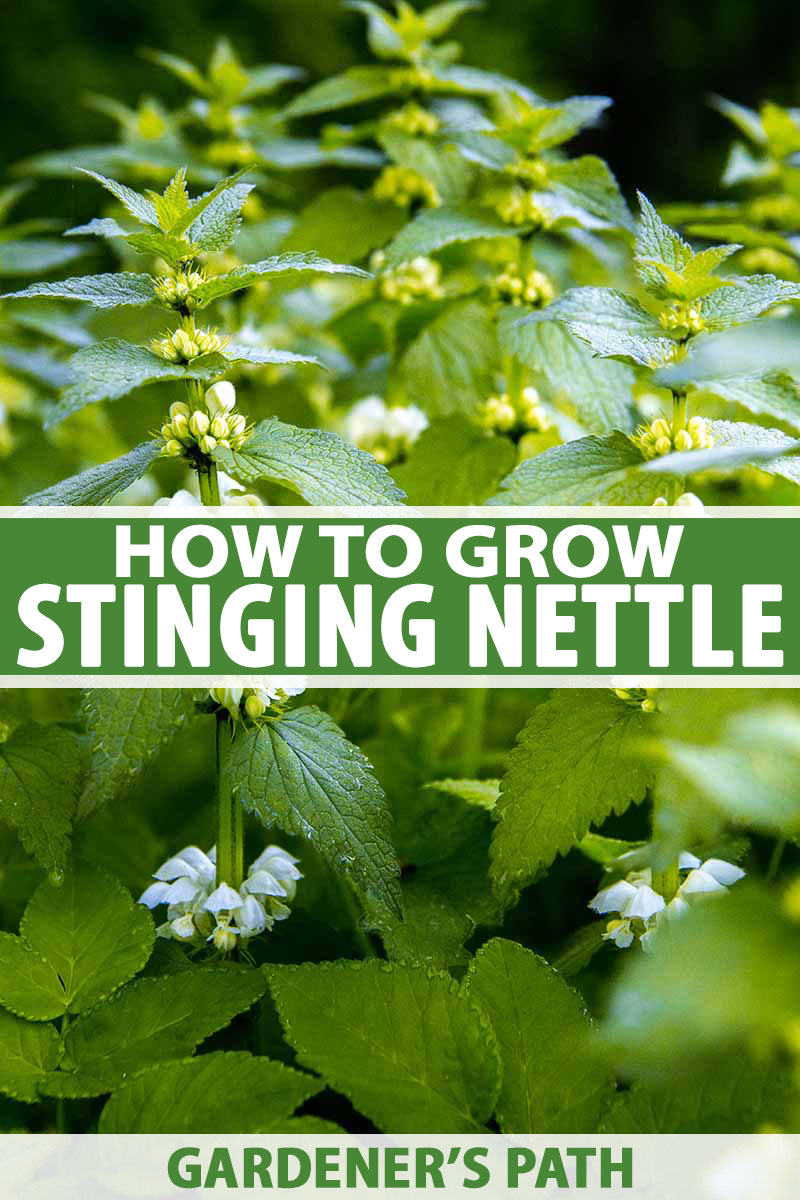
We link to vendors to help you find relevant products. If you buy from one of our links, we may earn a commission.
And so I started learning. I just needed to know why my landlord insisted so strongly on maintaining that pesky nettle patch.
The more I researched, the more I began to change my tune on nettle.
I learned, for instance, that it is one of the most nutrient-rich native herbs known. It is safe for almost everyone, has a plethora of uses, and is actually quite delicious.
I am now a complete convert. In fact, it might just be my favorite herb yet!
Will it become one of yours? There’s one way to find out! Let’s learn more.
Here’s what’s to come in this article:
What You’ll Learn
This versatile edible and medicinal herb is not often cultivated, but foraging it from the wild is certainly not your only option. Here’s how – and why – you should grow it at home.
What Is Stinging Nettle?
Nettle, Urtica dioica, is an herbaceous perennial in the Urticaceae family that is often found growing wild in the understory of riparian zones, on the edges of meadows, in open forests, or in disturbed soils near pasture.
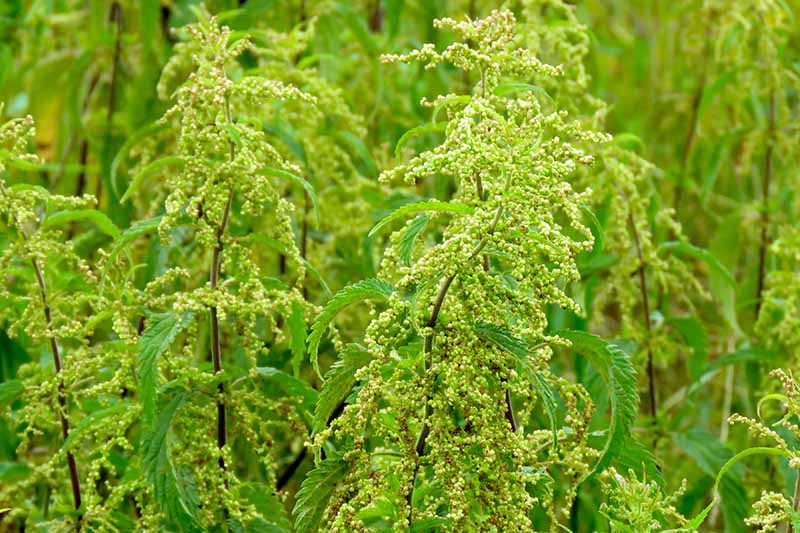
It has toothed opposite leaves along the stems, which are almost heart shaped, and very small flowers. It can grow from two to four feet tall at maturity. It spreads by vigorous creeping rhizomes, and often forms dense clusters.
Nettle plants are dioecious, which means they only produce either male or female flowers, not both. Perhaps this is why they were given the Latin name dioica, which means “two houses.”
Males have a stringier, compact cluster of flowers that tend to point outward. Females can be identified by dense, heavy flower clusters that may look like they are pulling the plant down.
Males and females grow adjacent to each other, and the flowers are usually wind pollinated.
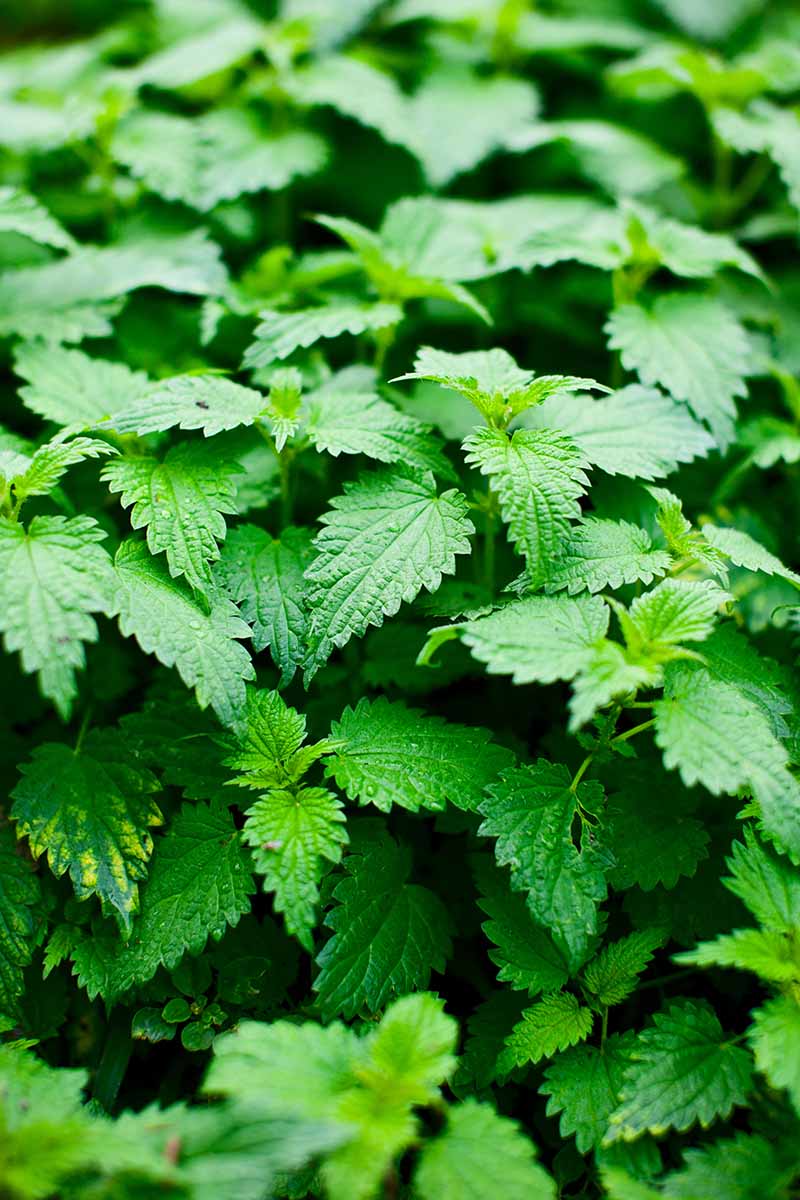
Perhaps the most infamous identifying feature is the tiny stinging hairs, which can be found under the leaves and along the stems.
These are actually tiny hollow tubes known as trichomes.
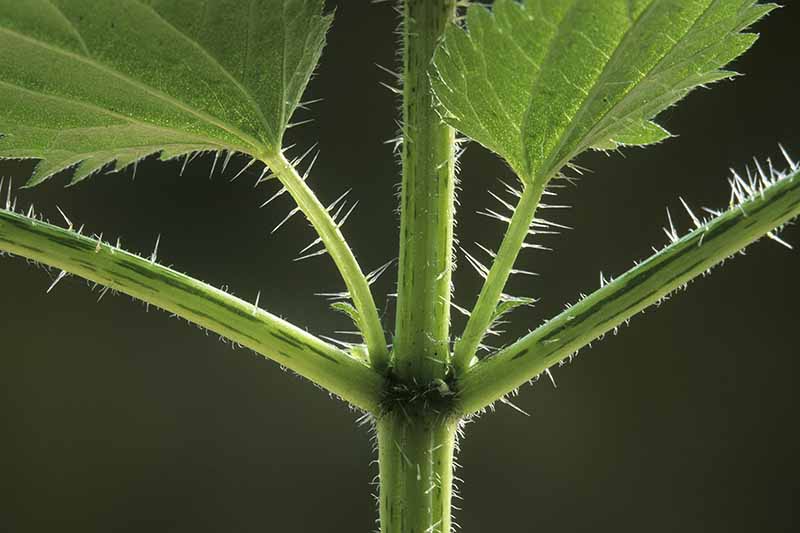
You may have had the misfortune of experiencing the unpleasant sensation of accidentally brushing up against a plant, or pulling one up without gloves.
The action of disturbing the hairs breaks off the fragile silica tips, and the hair acts like a needle, injecting you with chemicals.
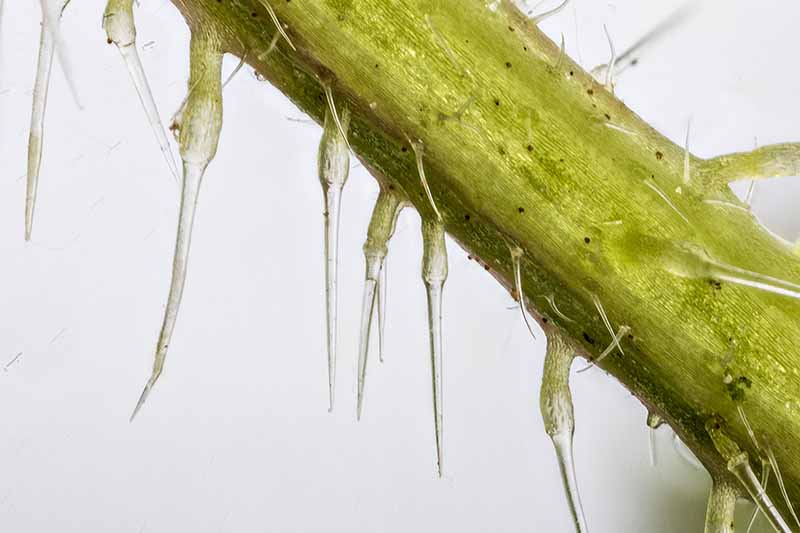
What causes that burning sensation?
Upon contact, the tiny needles pierce the skin and release chemicals including acetylcholine, formic acid, histamine, and serotonin, which trigger inflammation and pain that can unfortunately last for up to several hours.
Native in many places around the world, this herb can be found in north Africa, North America, Asia, and Europe. In some parts of the US, stinging nettle is considered an invasive weed due to its ability to self-seed and spread through its root mass.
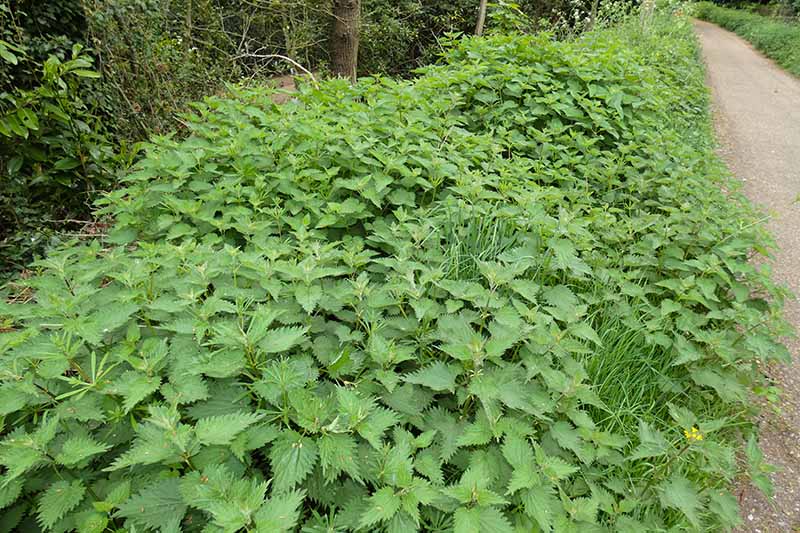
It has been grown, foraged, and harvested for thousands of years. Documented accounts of its use date as far back as 1200 BC, and its uses are widespread.
Nettle fabric was used by Europeans and Native Americans for linens and sailcloth as early as the 16th and 17th century.
Today, it is still commonly used as a textile similar to hemp or flax. Fibers can be dried, pounded, and twisted into rope or cloth. The finished product can range from fine and soft to thick and rough.

In Germany it was used during the first half of the 20th century, often combined with cotton to make undergarments, stockings, and fabrics.
This valuable plant also has long been part of culinary and medicinal practices. In the US, there is a history of Native American use in food, medicine, clothing, and ceremonies.
Medicinal Use and Herbal Remedies
All parts of the nettle plant are edible and are used by some practitioners today in herbal remedies. U. dioica has been used to address a range of ailments over the centuries.
Leaves, roots, and seeds have all been used medicinally, and each has different applications.
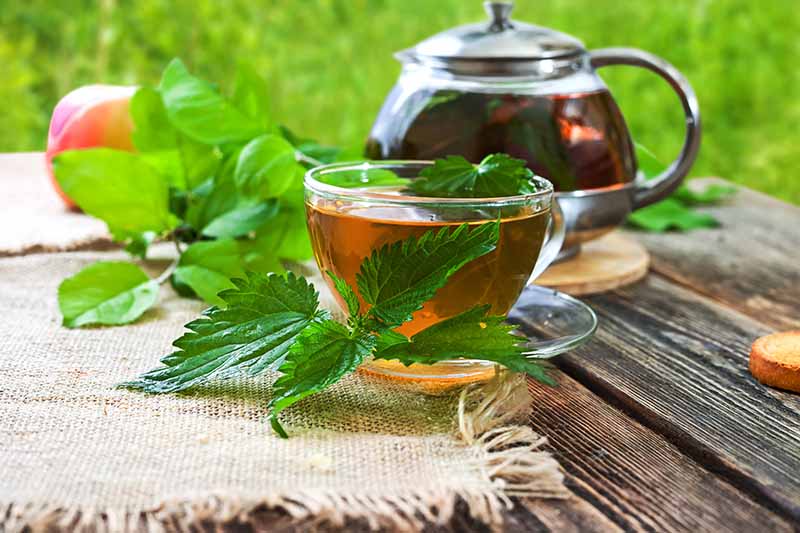
The nettle leaves are extremely high in nutrients and make a delicious tea. The flavor is sweet and salty, with a pleasant, earthy taste. Drinking it reminds me of sitting in a peaceful forest.
One of my favorite recipes is this iced fennel and nettle tea from our sister site, Foodal. It’s delicious on a warm day.
Although this particular recipe calls for store-bought nettle tea bags, I substitute those with a handful of fresh leaves from my own garden, or a smaller quantity of home-dried leaves.
According to Maria Noel Groves, author of “Grow Your Own Herbal Remedies,” one cup of tea infused for four to 12 hours contains “approximately 500 milligrams of calcium in a highly bioavailable form,” meaning it is easy for the body to absorb and put to use.
She goes on to say that it is also high in magnesium, potassium, silica, and chlorophyll.

I highly recommend Groves’s book, which is available from Amazon, if you want to learn more about how to use common plants as herbal remedies.
Nettle leaf tea can have diuretic properties and is often used to relieve the symptoms of urinary tract infections.
There are quite a number of claims about the healing properties of some root and leaf extracts, but many of these are inconclusive and largely anecdotal.
A double-blind, randomized clinical trial was conducted in 2016, where 50 women with type 2 diabetes were divided into two groups and one group was given an extract of U. dioica. The study concluded that the extract may decrease cardiovascular risk factors and other complications in patients with type 2 diabetes.
You can read more about harvesting and using stinging nettle roots here.
The sting of the fresh leaves is said to have healing properties, such as helping to reduce inflammation, improving circulation, and even combating allergies.
Some people purposely sting themselves to encourage the release of an anti-inflammatory response. This method has been used to reduce joint pain, such as what is experienced by those with arthritis.
A Note of Caution:
Always consult with a medical professional or trained herbalist before starting any herbal treatment. This herb should not be used during pregnancy, or by those who take prescription medication.
Propagation
Nettle is easy to grow and can easily be started by seed indoors, or divided from existing patches.
You can find packets of 500 seeds available from Earthbeat Seeds to get started.
To prepare for planting, look for an area with rich soil and sufficient moisture. Nettle does especially well on the edges of meadows, pastures, or streams where the soil stays moist but isn’t waterlogged.
Selecting your site with future spread in mind is also advised. These are hearty perennials with a tendency to become invasive, so choose wisely. If you are concerned about spreading, consider confining it to containers.
Pick a place where you are certain that you want them, perhaps not directly next to your veggie patch!
From Seed
Seeds are very tiny and require light for germination.
In the spring, broadcast seeds and press them lightly into the soil or cover with a very thin layer of soil, only about a quarter of an inch at most. Plants can later be thinned to an inch apart.
From Seedlings or Transplants
Sow seeds in flats in late winter. Seeds should germinate in approximately 14 days. Transplant outdoors in early spring, as soon as the ground can be worked. Space seedlings about eight inches apart.
Division
If you have a friend with a thriving patch, ask if you can dig up a couple of plants in late fall and replant them in your yard. They will spread quickly, once they become established.
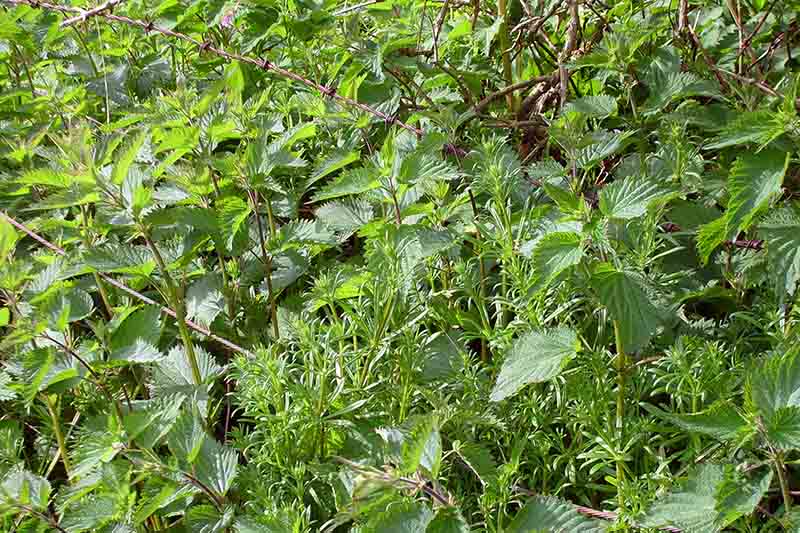
Or, why not find them in the woods? Nettles can also be foraged easily, and they grow as a weedy perennial all over the place.
If you can learn to properly identify them – which isn’t difficult if you touch them, but relying on visual cues is preferred! – you might realize that you already have some growing nearby that you can dig up and transplant to your garden.

Alternatively, if you do find a patch growing wild, you can gather the tiny seeds in early fall, once they have turned brown.
Just shake out a seed head into a jar or bag.
How to Grow
A very hearty plant, this herb will do well in a variety of climates and conditions. It can grow in full sun to partial shade and will tolerate soil with a wide pH range, anywhere from 5.0 to 8.0.
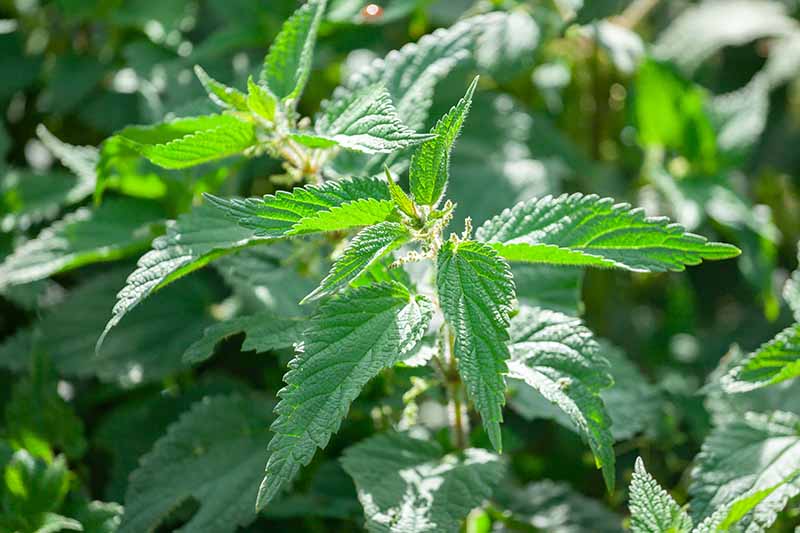
The main consideration is moisture. If a spot is too dry, plants may struggle and will lack flavor, and may potentially lack some of their potency as an herbal remedy.
Keep the soil moist throughout the spring until you are done harvesting, after which time the plants will usually take care of themselves.
If you want, you can incorporate some leaf mulch around the plants to help retain moisture during dry spells.
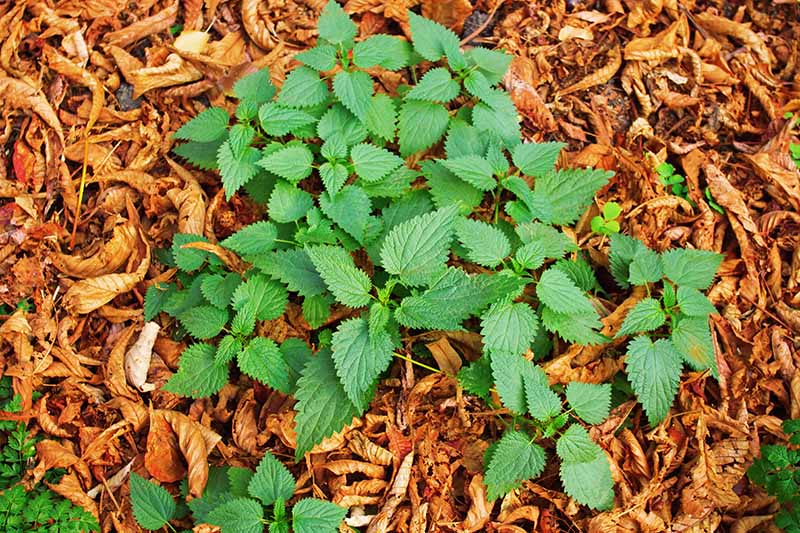
Additionally, these plants thrive on nitrogen rich soil, so it is a good idea to dig some composted manure into the soil where you are planning to plant.
Nettles don’t need much maintenance after harvest season, as they are very hardy and spread easily. Just harvest regularly to encourage new growth, and keep an eye on them in case they start to spread to areas where you don’t want them to grow.
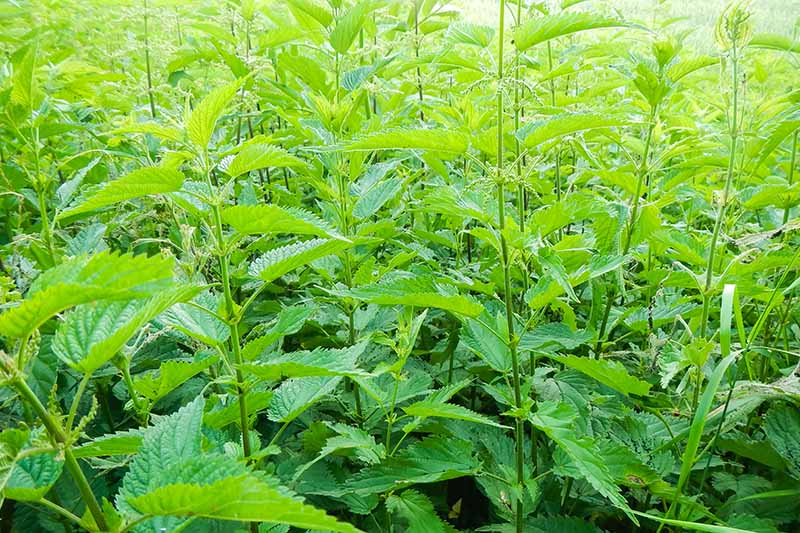
You may choose to cut off the top third to keep plants from becoming too tall and toppling over.
After removing stalks, leave them to decompose on the ground around plants. This will return nutrients to the soil, and the added mulch layer will help retain moisture in the spring.
You can also cut off the flowering seed heads when they form, which will encourage a better crop next year, as less energy will be diverted to seed production. This may also help to reduce spreading if you are concerned about the patch getting away from you.
Over the winter the foliage will die back and the plants will go dormant, reemerging in spring.
Growing Tips
- Keep the soil moist but not waterlogged.
- Plant in a location where you can manage it, as this plant has a habit of taking over.
- Plant in full sun or partial shade.
Managing Pests and Disease
Never mind worrying about pests and disease. Another benefit of growing stinging nettle is that it actually can reduce the risk of pest infestation for surrounding crops.
This is because it attracts various beneficial insects, and several butterfly species.
In a study by David James, associate professor of entomology at Washington State University, from 2011 to 2013 researchers monitored beneficial insect populations in U. dioica patches at three locations in the Yakima Valley.
Each year over the course of three years, they found 200 to 400 beneficial insects trapped in nettle plants at all three sites.
Insects found included predatory bugs, predaceous flies, parasitic wasps, and native bees.
It was concluded that nettle could be a great biological control for managing insect pests, and was recommended for use in vineyard habitat restoration and pest management, as well as for butterfly conservation.
Harvesting
Harvesting nettles can sound intimidating, but with a few precautions in mind, you won’t get any trouble from the pesky needles.
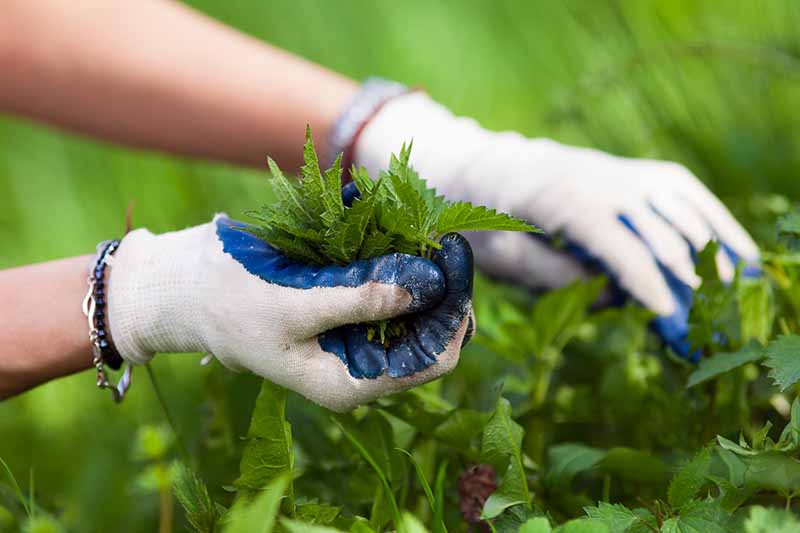
Just be sure to wear gloves, long sleeves and pants, and closed-toe shoes. Bring a basket, bucket, or paper bag, and a clean and sharp pair of scissors.
For food and making herbal remedies, harvest the foliage when the stems looks juicy, before flowering.
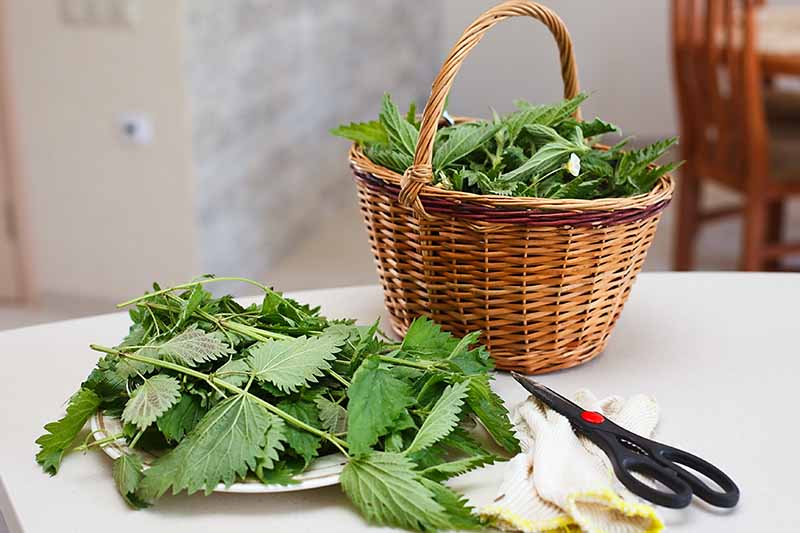
Once plants flower and start to look woody and fibrous, leaves become stringy and tough.
To harvest, cut back the top third of the plant, just above a node where leaves branch off, which will encourage new growth.
Be conscious about what you are doing. The needles are generally pointed downward, so work from the top of the plant downwards.
Preserving
The leaves can be preserved and consumed in a number of ways.
Cooking, drying, crushing, or blending will remove the stings, making leaves safe to handle and eat.
As long as you use one of these methods, nettle leaves can be a part of practically any dish, used in a similar way to spinach or other leafy greens.
You can store the fresh leaves in the refrigerator for two to five days, just make sure they are kept in a closed container to prevent them from inadvertently stinging anyone!
Drying
Dry in a dehydrator on the lowest temperature setting, about 95°F for 12 to 18 hours.
You can also hang leaves to dry in small bunches.
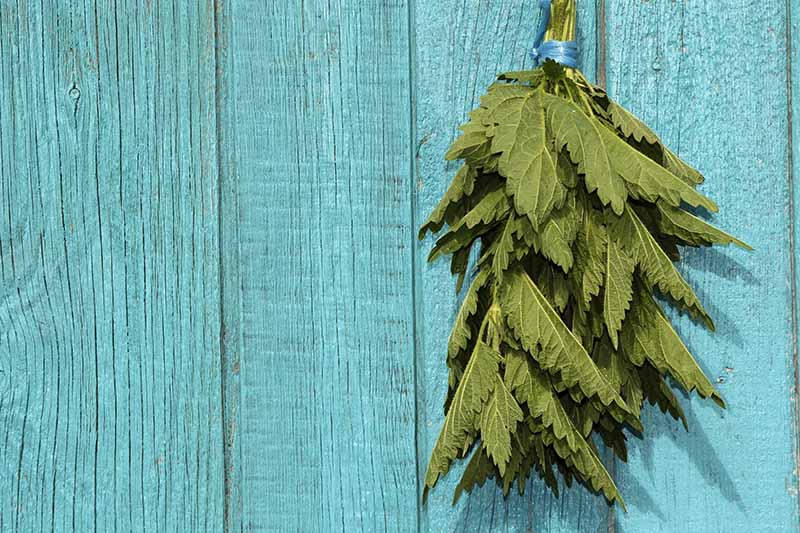
Just bundle up six or seven stems, and hang them in a dry, dark place with good air circulation. The drying time can vary depending on your location and the relative humidity, and it could take anywhere from one to a few weeks.
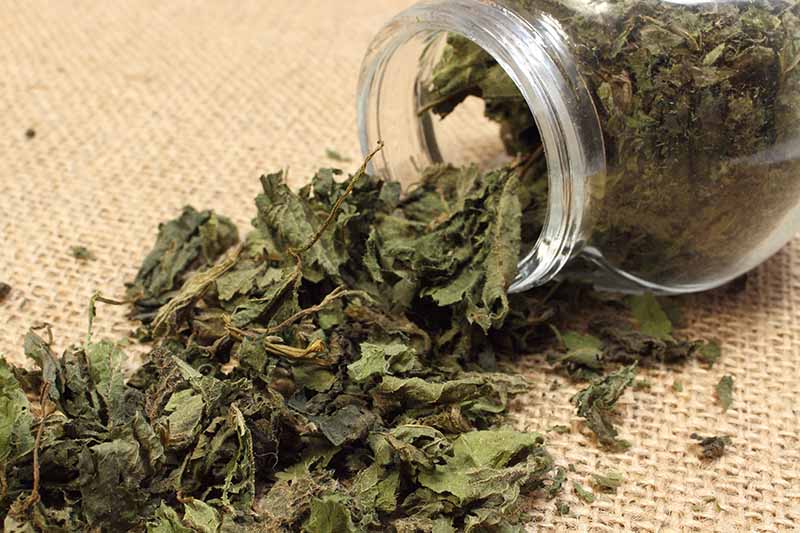
To store, remove leaves from the stems and secure in tightly lidded glass jars. Keep in a dark place, such as a pantry.
Dried leaves can also be ground into a powder for use in cooking, to make tea, or as a nutritional supplement.
You can find more tips on drying herbs here.
Freezing
Before freezing, you’ll want to blanch the leaves to remove the sting.
To blanch, place in boiling water for a minute or two, and then quickly douse in ice water.
Squeeze to drain as much moisture as possible, chop, and place in freezer bags or containers.
Frozen nettles are a great addition to any food that would be good with added greens. Throw them in soups, pasta, stir fries, stews, or omelets.
You can find more tips on freezing herbs here.
Tinctures, Vinegars, and Oxymels
To make a tincture, you can infuse dried or fresh leaves in alcohol or vinegar for use as an herbal remedy.
I use around four ounces of dried leaves to 16 ounces of vodka or vinegar. If you’re using fresh leaves, it’s best to chop them and use about eight ounces of leaves to 16 ounces of liquid.
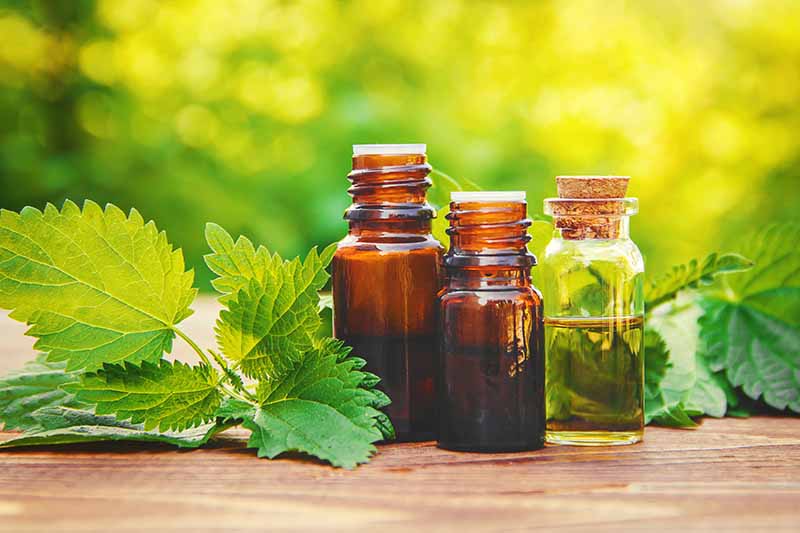
Place the mixture in a tightly lidded jar in a dark location, and shake it daily. Let it sit for about a month and then strain. To use, dilute a few drops of the tincture in half a cup of water and drink as a general health tonic.
Infused tinctures can be stored in a cool, dark place for three to five years.
Infused vinegar can impart a pleasant flavor when used in cooking. You can also try blending the infused vinegar with honey to make an oxymel, which is perhaps even tastier!
Cooking Ideas
Once you’ve harvested the greens, you can use them as you would any leafy green. Keep your gloves on when you wash them, carefully removing any dirt or insects.
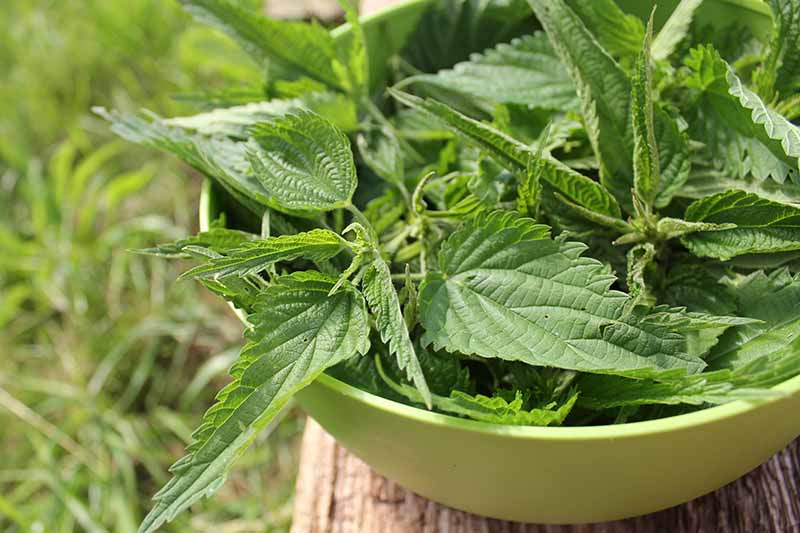
Their flavor has been described by TV Chef Hugh Fearnley-Whittingstall as “irrefutably green,” somewhere between spinach, cabbage, and broccoli, with a unique hint of nettliness: a sort of slight, earthy tingle in your mouth.”
I couldn’t have put it better myself!
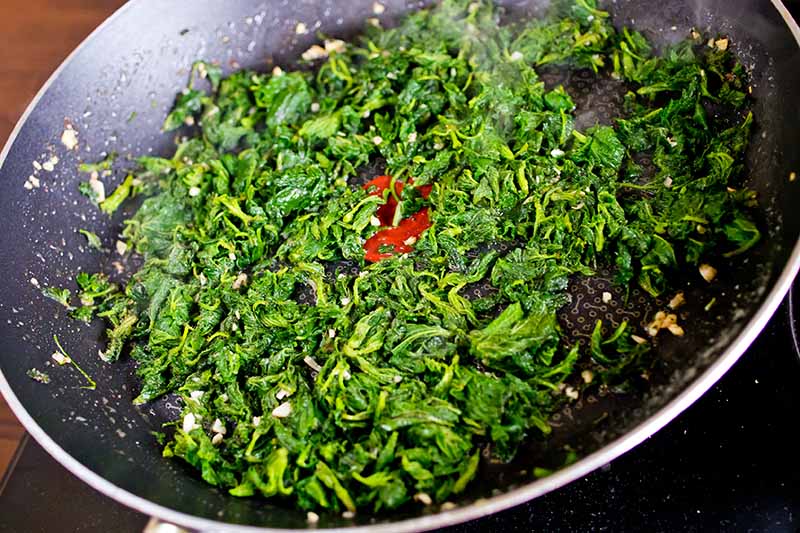
They can be used to make a fresh nettle soup, added to stews, used in baking, or simply sauteed in a little butter and garlic as a side dish.
I’ve even made nettle pesto – but I made sure to blanch the leaves before throwing them in!
Just remember not to put a fresh nettle leaf on the side of the plate to garnish your dish, or you may end up with a prickly surprise.
Fresh leaves can also be used in cheesemaking as a vegetarian substitute for rennet.
But for this you’ll need a big harvest – two pounds or more of fresh leaves, simmered in four cups of water with a tablespoon of non-iodized salt for 30 minutes.
After disposing of the leaves, the liquid can be stored in the refrigerator and used in place of animal rennet. You’ll need about one cup of liquid nettle rennet per gallon of milk.
Quick Reference Growing Guide
| Plant Type: | Herbaceous perennial | Water Needs: | Moderate |
| Native to: | Europe, Asia, North Africa | Maintenance: | Low |
| Hardiness (USDA Zone): | 3-10 | Soil Type: | Average |
| Season: | Spring, fall | Soil pH: | 5-8 |
| Exposure: | Full sun, partial shade | Soil Drainage: | Moist |
| Time to Maturity: | 80-90 days | Tolerance: | Frost |
| Spacing: | 8 inches | Pests & Diseases: | Repels most pests |
| Planting Depth: | Surface | Family: | Urticaceae |
| Height: | 2-4 feet | Genus: | Urtica |
| Spread: | 1-5 feet | Species: | dioica |
Much More than Just a Sting
Though seen by many as an irritating weed, nettles have been appreciated by foragers for a long time, and they are so much more than just a menace to be wary of.
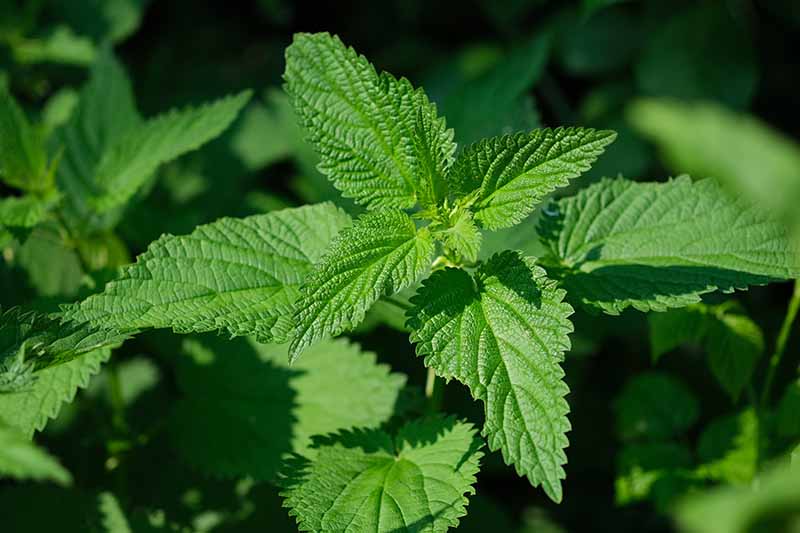
When we take the time to appreciate their value and learn to handle them with care, nettles are really an incredible herb with so much to offer us.
If this article hasn’t quite won you over yet, I encourage you to taste some nettle tea for yourself. You may quickly be convinced, as I was, that this plant is well worth the hassle of cultivation – and perhaps the very occasional sting.
What is your favorite way to use stinging nettle? Tell us your thoughts in the comments below!
If you’re interested in growing other medicinal herbs, you’ll need these guides next:
- How to Grow Bee Balm: Bring Out the Hummingbirds
- How to Grow Fenugreek
- How to Grow and Use Lemon Balm
© Ask the Experts, LLC. ALL RIGHTS RESERVED. See our TOS for more details. Product photos via Crossing Press, Earthbeat Seeds, and Storey Publishing Uncredited photos: Shutterstock. With additional writing and editing by Clare Groom and Allison Sidhu.
The staff at Gardener’s Path are not medical professionals and this article should not be construed as medical advice intended to assess, diagnose, prescribe, or promise cure. Gardener’s Path and Ask the Experts, LLC assume no liability for the use or misuse of the material presented above. Always consult with a medical professional before changing your diet or using plant-based remedies or supplements for health and wellness.

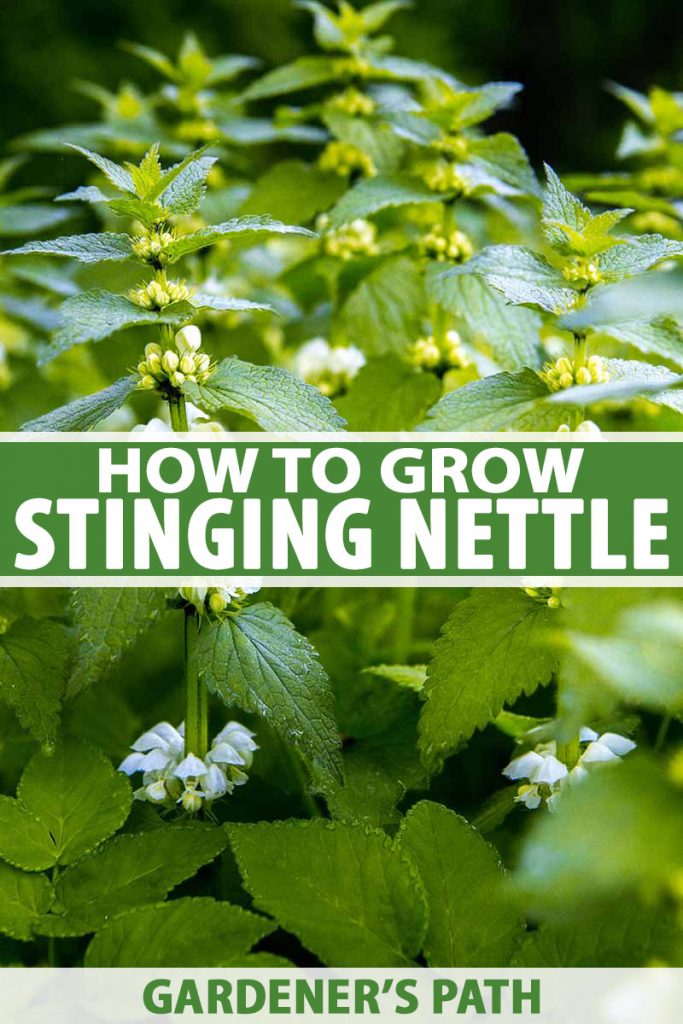
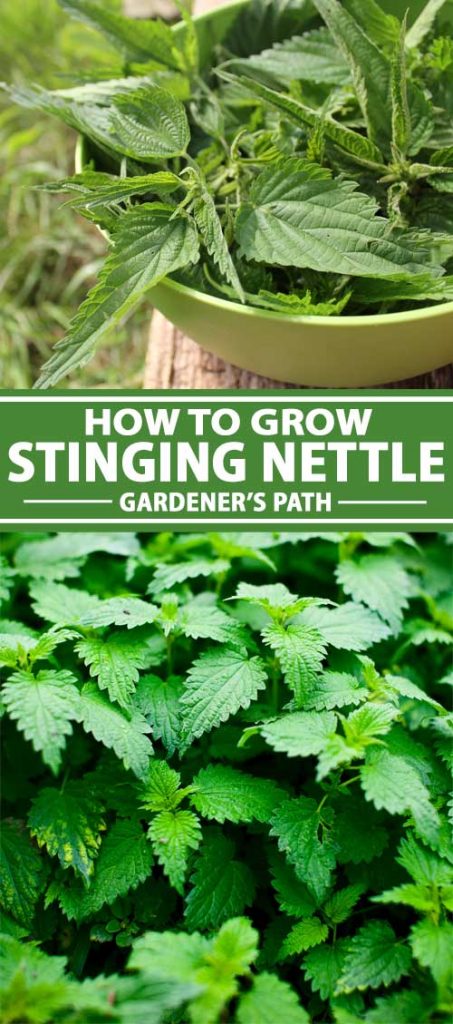
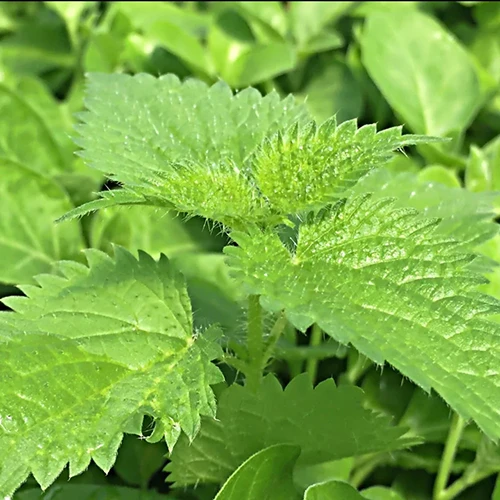
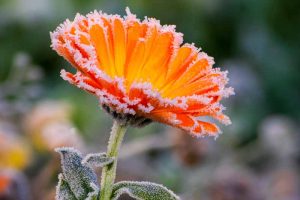
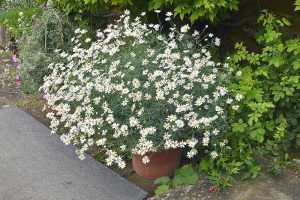
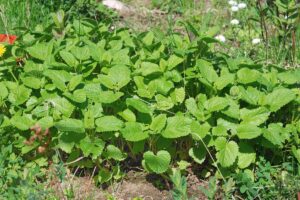
Nostalgic! In the 80’s, we used to go into the wild in search of stinging nettles. Though it stings the hands, it does not sting the gut. It is garnished with okra and red pepper and little palm oil to make a delicious soup called “ofo akuba” -nettle soup in Abiriba, Nigeria. I remember my mum using it to treat wounds on people. I think I will domesticate it in the nearest future. Thank you for this info.
Yum, that soup sounds delicious, Onwuka, and I would love to try it! I didn’t grow up eating much okra myself, but I have grown to love it as an adult, especially in Indian subzi recipes. One of the most interesting ways of enjoying nettle that I’ve ever tried is in cheese- it’s popular in the Netherlands, and the herb adds just a touch of flavor that combines nicely with creamy dairy.
Thank you for the information! You know your way around the Nettle plant. Now I feel confident I can care for mine!
Your first photo is dead nettles not nettles. Dead nettles are in the mint family and are not the same as nettles!
Thanks Erin, we’ll look into this!
Hi could you please explaine what the difference is between dead nettles and nettles?
I cannot see an answer if the nettle plant can be sowed from seeds and where to get these seeds.
Hi Hari. See the section on propagation above for instructions to start nettle plants from seed. We have also updated the article to include a link to purchase seeds from one of our trusted affiliates. Hope this helps!
Thank you for the information. Could you please help me identify if this plant here in the picture is stinging nettle plant!
Hi Fouzul, It is challenging for me to ID a plant by just a photo or two, but my hunch is that this is something else. Take a look at this plant and notice whether the leaves are opposite each other or alternate. How tall does the plant get? Is the stem erect? Does it seem to spread like a weed? Stinging nettle leaves are opposite, toothed, almost heart shaped with pointed tips, about 2-5 inches long. The stalks and erect stems are covered in tiny brittle hairs that sting if you touch them. Later in the summer, nettles develop… Read more »
Hello there, I have access to a large healthy looking stand of nettle but it is growing in brackish water, the source I am not sure of, but possibly contaminated. would it be safe to use? does it filter out pathogens? any advise would be very appreciated as my system does seem to respond well to nettles for keeping my allergies at bay.
Also have a similar situation with some patches of Yerba de Manso..it likes soggy earth but not sure if the water around it is clean.
Thanks, Susan
images of the nettle patch
When in doubt, do not forage! Unless you’re confident that the plants as well as the surrounding environment are safe, I caution you to skip picking from this location. Even wilderness that appears pristine may conceal contaminated soil and water, and potentially contaminated sites should be avoided. Pathogens may contaminate surfaces via splashing water in many cases, and ongoing research indicates the use of nettles for drawing biphenyls and heavy metals from soil – a potential boon in the case of something like nutritive iron, and a potential health risk in the case of PCBs, lead, and cadmium. One study… Read more »